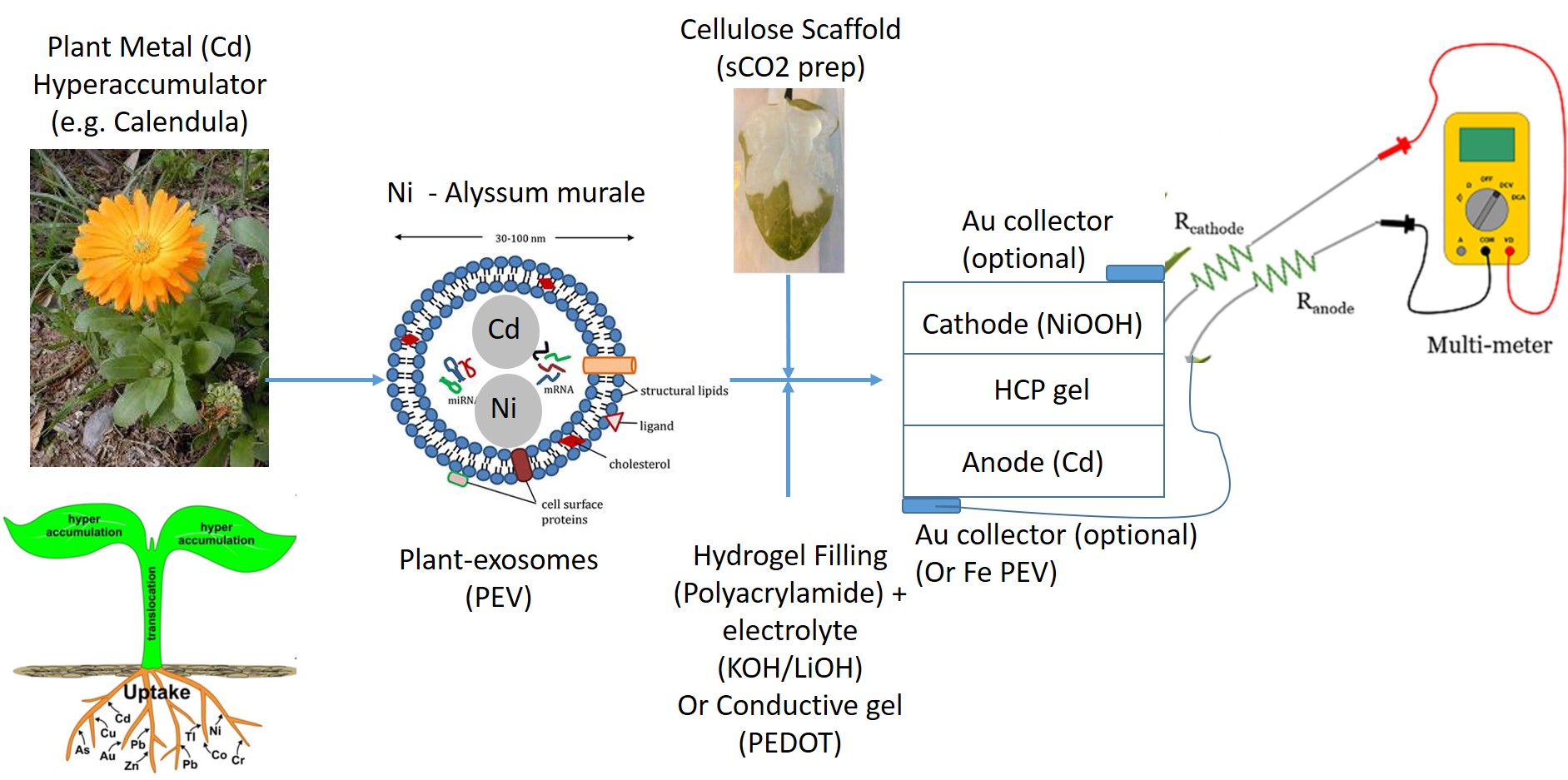About This Project
Green electrical energy storage solutions are needed to power booming number of smartphones and wearable devices. Flexible batteries are practical solutions, but power densities, mechanical properties and printing processes impede reliability and performance. Now imagine by combining decellularized leaf scaffolds retaining their vasculature network with integrating metal hyperaccumulator plant nanovesicles, flexible, green and rechargeable Zn-based batteries could be fabricated.
Ask the Scientists
Join The DiscussionWhat is the context of this research?
The rise in self-powered electronic devices, such as wearable sensors, requires more efficient flexible batteries. Rechargeable polymer-metal based batteries are not eco-friendly, poorly reliable and limited in performance. Metals can be extracted from soils by hyperaccumulator plants through phyto-assisted conversion and reactions. Plant scaffolds are mostly composed of cellulose which can be prepared by green decellularization processing without chemical solvents. Cellulose fibers and pores of the scaffold can be impregnated by natural hydrogel polymers while metal nanoparticles can be produced by the plant hyperaccumulator exosomes (PEVs). This will create completely green flexible batteries-on-leaf at low cost.
What is the significance of this project?
This project could provide novel electrical-power source directly integrated with plant materials ideally suited for self-powered electronic, but also biomedical devices such as smart wound healing materials for locally stimulating biological reactions with therapeutic effects. These may also be combined with embedded electronic circuitry to actuate, monitor or control wearable or implanted medical devices. It is also foreseeable that culturing plant using hydroponic conditions, these systems could be prepared, assembled and used on-demand, that would make them suitable for supporting broader needs for remote space health monitoring for deep space flight missions, mobile operations for disaster response or global health. This will provide real "green" power.
What are the goals of the project?
The goal of this project is demonstrating a plant-like battery. First, we will culture several plants metal hyperaccumulator in soil and in aquaponic conditions to isolate and characterize the plant-vesicles (PEV). Then, size distribution will be measured by Dynamic Light Scattering (DLS) and Transmission Electron Microscopy (TEM). PEV content for metal encapsulation will be determined by Atomic Absorption Spectroscopy (AAS). Next, leaves scaffolds will be decellularized by green supercritical fluid CO2 and impregnate with conductive hydrogels to prepare the flexible battery substrate. Last, all components will be assembled with electrode contacts for measuring electrical density, assess charge cycles and characterize reliability of a battery-on-leaf concept.
Budget
Plant-derived nanovesicles (PEV) are an emerging alternative for mammalian cell culture-derived particles (EV) or even nanolipid particles (NLP) used for targeted drug or vaccine deliveries (e.g. COVID-19). Recently, we got awarded a pilot grant from NIH/NIAID to develop PEVs for radiation countermeasures delivery. Here, with the proposed budget, we will exploit our isolation methods under NIH project to explore how PEV from special plant metal hyperaccumulator combined with a decellularized leaf scaffold could provide the components for prototyping a green flexible Zinc-metal (or Ni, Mn and Cd) into a first rechargeable "battery-on-a-leaf". The budget will support demonstration of this exploratory work to build a green alternative to energy sources and highlight the feasibility of hyperaccumulator PEV electrical sources for self-powered wearable but also implantable devices. The funds will assist in getting preliminary data for future grants.
Endorsed by
 Project Timeline
Project Timeline
A period of performance of 6 months is planned for this project demonstration. The first 2 months will focus on tasks related to the screening of lead candidates from metal hyperaccumulator plants and optimizing the PEV isolation, purification and characterization methods. The next 2 months will compare culture techniques, components assembly and electrical testing. The last 2 months will be for testing the battery functionality and draft report / publication.
Sep 05, 2022
Plant screening, selection of lead candidate, PEV isolation method(s) optimization (ultracentrifugation versus size exclusion chromatography or others)
Sep 08, 2022
Project Launched
Oct 31, 2022
PEV size distribution & morphology analysis (e.g. DLS, TEM) as well as metal concentrations (e.g. AAS)
Dec 30, 2022
Comparative study of soil versus aquaponic grown hyperaccumulator plants conditions and impact on PEV properties (e.g. morphology)
Jan 30, 2023
Optimization of PEV Metals (e.g. Zn, Ni, Cd) loading
Meet the Team
Affiliates
Frederic Zenhausern
Dr. Zenhausern ("Dr. Z") has several academic affiliations. At present, he is co-Chair and Endowed Chair Professor of Basic Medical Sciences, Professor of Clinical Translational Sciences, Professor of Radiation Oncology at the College of Medicine, Phoenix, and Director of the Center for Applied Nanobioscience and Medicine (ANBM) at the University of Arizona. He is also member of the Therapeutic Development Program at the University of Arizona’s Cancer Center, member of BIO5 and Professor at the Department of Biomedical Engineering, College of Engineering.
Dr. Zenhausern is a clinical research investigator at the Honor Health Research Institute. Dr. Zenhausern is also professor at the Translational Genomics Research Institute (TGen) and adjunct professor at the University of Geneva’s School of Pharmaceutical Sciences. He is Fellow of the U.S. National Academy of Inventors (NAI) and a Fellow of the American Institute of Medical and Biological Engineering (AIMBE).
He is co-founder of 4 successful startup companies and authored more than 80 peer-reviewed publications and proceedings with more than 30 U.S. Patents. He spent over a decade in industry at IBM T.J. Watson Research Center and Motorola Labs, where he pioneered ultra-high-resolution imaging spectroscopies and genomic platforms.
Dr. Zenhausern received his B.S. in biochemistry from the University of Geneva, his M.B.A. in finance from Rutgers University and his Doctorate Es Science in Applied Physics / Condensed Matter at the University of Geneva.
Zenhausern team pioneered organ-on-chip technology, rapid DNA forensics, molecular diagnostics for early disease detection but also portable fuel cell technologies for wearable electronics.
More recently, Dr. Zenhausern technology was selected to be the first molecular diagnostics to be performed in spaceflight by the civilian crew astronauts from the Space X Inspiration 4 mission.
Lab Notes
Nothing posted yet.
Additional Information

Project Backers
- 3Backers
- 2%Funded
- $60Total Donations
- $20.00Average Donation

